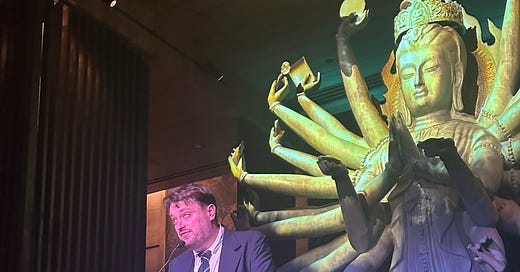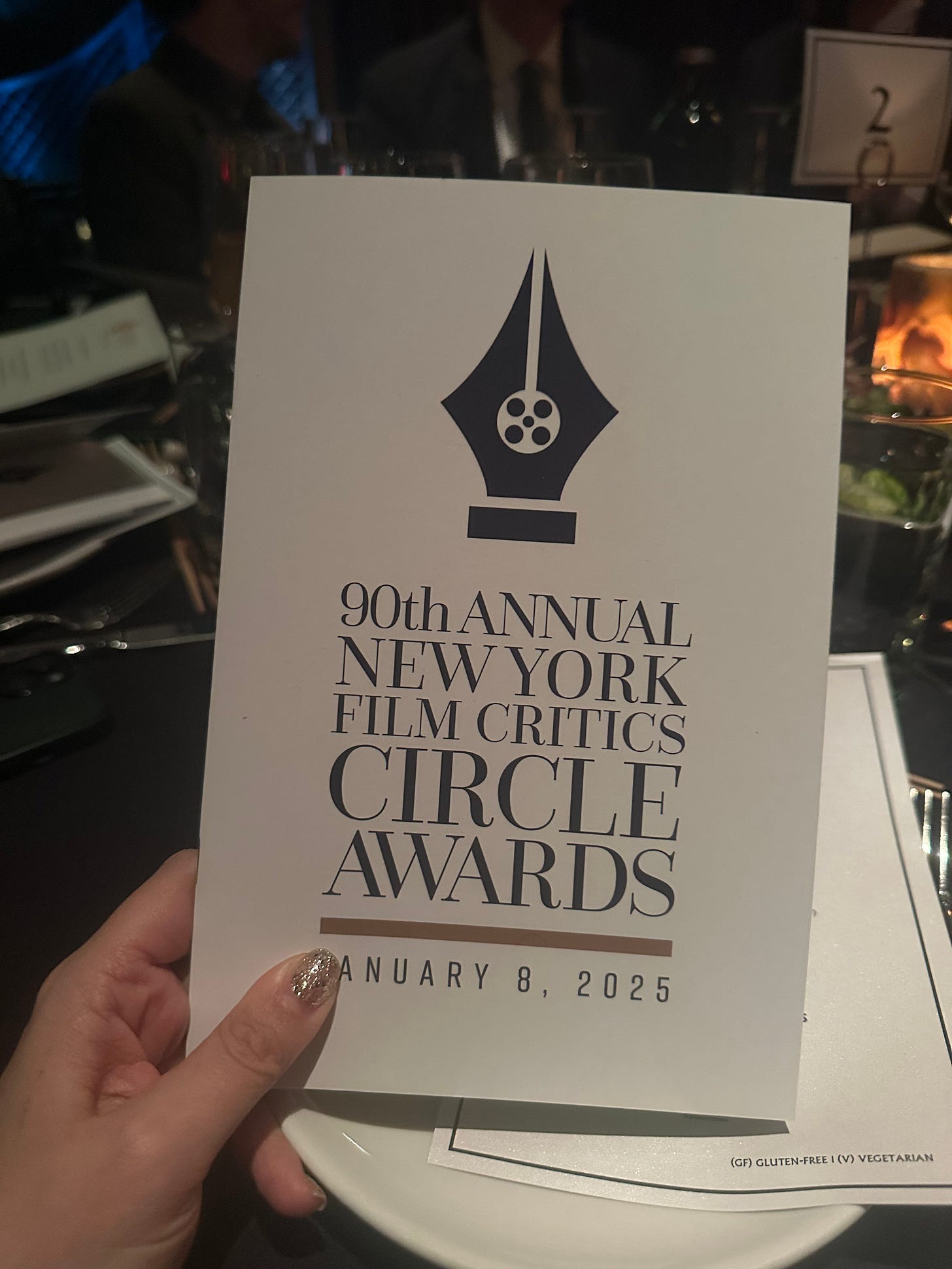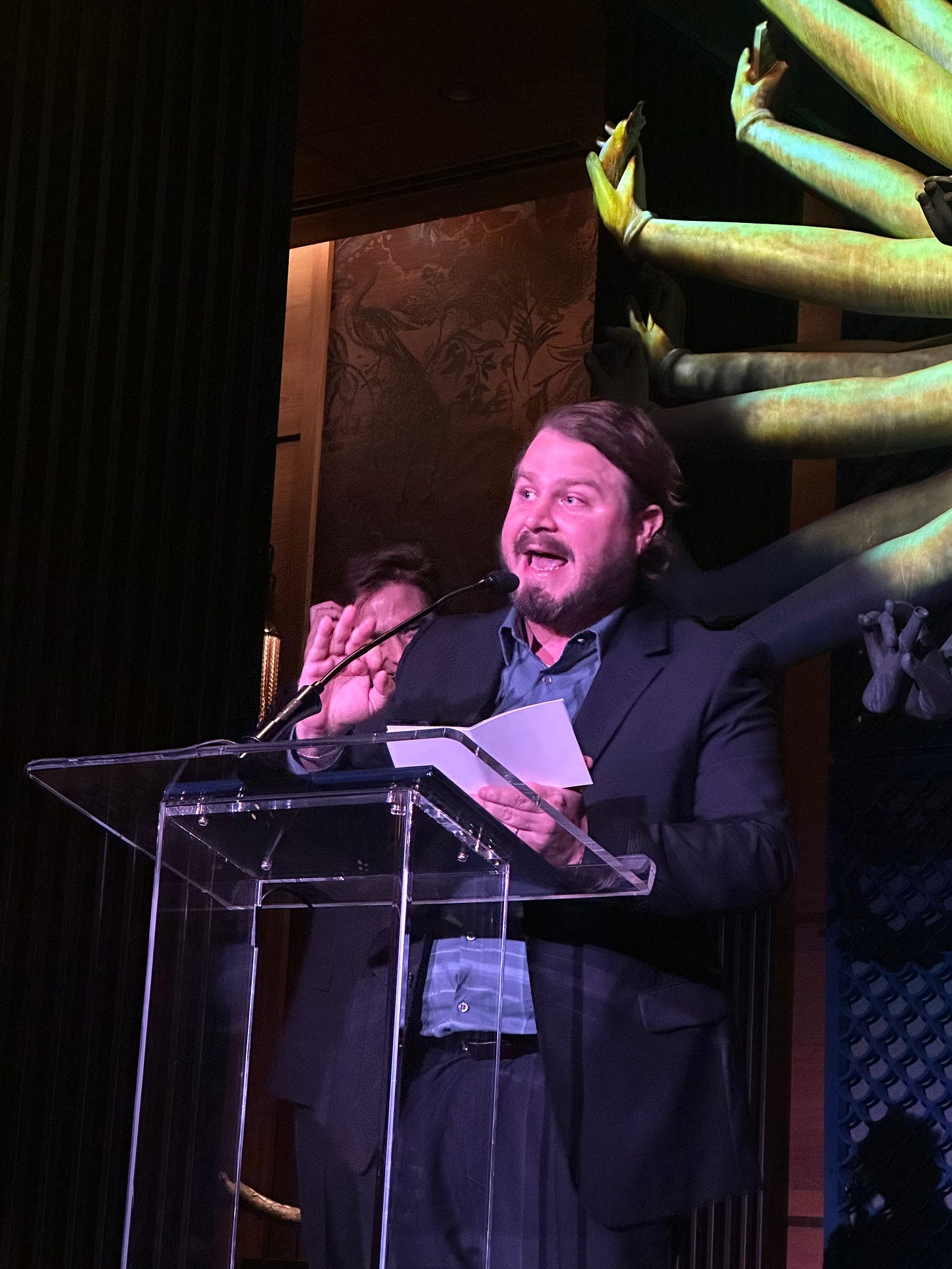Surprise! Blank Check has started a newsletter! Your favorite connoisseurs of context are gonna go on even more tangents, commit to even more bits, and share opinions on even more pieces of entertainment industry news because - hey, why not. Thanks for joining us!
IN THIS WEEK’S EDITION:
THE BARDI PARTY REPORT
On Wednesday, January 8, “Hollywood’s Biggest Night” was, for a brief moment, in New York City and emceed by David Sims.
I’ve had the pleasure of attending the New York Film Critics Circle Awards Dinner for several years as a glamorous seat-filler (“Guest of IndieWire’s David Ehrlich”), but this year was special because the two Davids (Sims and Ehrlich) were chair and co-chair of the festivities. This meant that Sims gave opening remarks and handed out the awards, that Ehrlich shadowed Sims to learn how to be next year’s chair, and that the honored guests of The Davids got the best seats in the house. Our table of hotties and legends was comprised of myself, Forky, Griffin, Ben, Fran of Fran Magazine, Emma Stefansky of bugs, and my girls Elisa (wife of Ehrlich) and Christina (purchaser of the infamous Titanic the Board Game). By virtue of our seating arrangements, I found myself sipping my “BrutalSpritz” cocktail directly next to Brady Corbet. More on that later.
I’d be remiss not to mention the heavy cloud of sadness that hung over the night. Despite this being a New York affair, it’s also very much a Los Angeles one. Between the Golden Globes on Sunday and the NYFCC dinner on Wednesday, the awards season’s vibe had shifted and priorities changed. You could sense that folks weren’t quite sure how much they could or should be celebrating. The first person I saw when I walked into Tao Downtown was native Angeleno Esther Zuckerman, and the first words out of my mouth were “Oh my god, you look stunning,” followed by “Oh my god, are your parents okay?” Thankfully, Esther’s parents were not only spared by the wildfires, but they were at the event in New York, and I got to meet them. Lovely people, unsurprisingly.
Although we are podcast cohosts with The Atlantic’s David Sims, we weren’t sure what to expect from his award hosting performance. Would he follow in the footsteps of previous host Jordan Hoffman and give a full Borscht Belt set? Would he perform a surprise musical number? Griffin floated the idea of hiring Bruce Vilanch to punch up David’s bits, which would have been SOMETHING, that’s for sure. But instead, David stuck to what David does best—reading a dossier about the NYFCC’s storied history and membership, thanking Forky and expressing exhaustion over having three kids, and speeding the evening along at a brisk pace. Not once was he interrupted with the retired England bit, not even when Mike Leigh came on stage to a standing ovation.
The first award of the evening was given to Janet Planet’s Annie Baker for Best First Film. Very deserved, of course, but it’s of more relevance to the Blankies that the award was presented by Wallace Shawn and all of us at Table 2 whispered “Come innnnnnnn” in unison as he stepped up to the microphone.
Most of the speeches from honorees landed on the more heartfelt end of the spectrum. Cinematographer Jomo Frey, awarded for his work on Nickel Boys, moved me to tears when discussing his mother’s experience seeing the film for the first time. When accepting her award for Best Supporting Actress, Carol Kane’s legendary voice cracked with emotion as she thanked everyone from Mike Nichols to Sean Price Williams. And in the ceremony’s most widely-reported moment, Adrien Brody held back tears as he reflected on the utter devastation of the Los Angeles wildfires. What the mainstream press won’t tell you, and what you’ll only get from the Bardi Party Report™, is that he segued into this tearful moment by throwing our own David Sims under the bus for erroneously referring to the giant statue on the Tao stage as a Buddha when “it’s actually Shiva the Destroyer.” Um, actually Adrien, it is a giant Buddha (the Guanyin, Bodhisattva of Compassion) and it says so on Tao’s website. This feels like such a Curb plotline, I can’t even tell you.
Going from the titular brutalist architect to the architect of The Brutalist, here are my notes on Brady Corbet: Dude’s truly just one of us. Laughed at every joke, nodded in approval at every deep cut reference. If I’d had but one more “BrutalSpritz,” I would’ve told him I worked on Her Smell, and that when we were all at TIFF, we saw Vox Lux and thought, “Damn, our movies are kinda similar but Vox Lux is INTIMIDATING.” And then I would have said, “Oh, hey, by the way, I work with Blank Check, it’s a podcast about filmographies, directors who…” and he would have interrupted and said “Blank Check, love you guys!” and we could have invited him on to talk about Riding in Cars With Boys or something.
Alas. Maybe next year.
A BRIEF MOMENT OF SELF-PROMOTION:
Ummm did you guys know that Griffin was in a movie called Turn Me On and it’s cool and sexy and life-affirming and now available to rent on VOD?
Well, now you do.
LET’S CRACK OPEN THE DOSSIER
I should probably clear something up right off the bat: yes, I made a very silly typo in the dossier for this week’s episode lol. It turns out that William Friedkin’s 1980 film Cruising is not spelled like Cruisin’; I blame all the piggy bank quarters I poured into the similarly named Midway arcade game, which I just learned is actually titled Cruis’n. This also means that, yes, Steven Spielberg was attached to *that* Cruising. In 1971, French Connection producer Philip D’Antoni purchased the rights to Gerald Walker’s 1970 novel Cruising. Soon after, D’Antoni—having been impressed by Duel—approached Spielberg to direct the adaptation. As part of the pre-production process, Spielberg was paired with Randy Jurgensen, an experienced NYPD detective who began a side career as a film consultant on French Connection. Jurgensen served as Spielberg’s tour guide through the real-life locations that inspired the events of Walker’s novel, and, at one point, he even showcased some advanced interrogation techniques for—or, rather, on—the director. Per Jurgensen, “[Spielberg] said, ‘How would you do this?’ and I put him up against a wall. I went top to bottom [frisking him], and I kept telling him, ‘Whatever the situation is, I must now be in control of it. I have to be in control.’ The way I’m saying that to you is the way I said it to Spielberg, and to this day he tells people I scared him during that interview!”1 Ultimately, however, D’Antoni couldn’t find a script up to his standards, and Spielberg returned to Los Angeles, finding less grisly—and controversial—material for his debut theatrical studio feature. When asked in 2013 what Spielberg’s version of the film might have looked like, eventual director William Friedkin said, well, “There might have been a shark running around in the damn club!”2
Brought in to shoot The Sugarland Express was legendary cinematographer Vilmos Zsigmond. Per Spielberg, “I'd heard about this crazy Hungarian who lights with six foot-candles and who'll try absolutely anything — so I sent the script to Vilmos and he loved it.”3 Though Spielberg’s favorite of Zsigmond’s films at that point in time was Robert Altman’s McCabe and Mrs. Miller, the director had no interest in aiming for something so overtly stylized on Sugarland; instead, per Zsigmond, Spielberg wanted a gritty, documentary look for the film, aligning it most closely with a different Zsigmond movie: “[W]e aren't really going for a definite style on this picture. What we're going for is reality. … [W]e're trying to avoid lighting the film. We're trying to make it look as though there're no cameras and no lighting involved at all. I tried to do the same thing on Deliverance and most of the time it worked, but I think this is going to be even more ‘real’ than Deliverance.”4 Shortly after the film’s release, however, Spielberg fretted that he and Zsigmond hadn’t leaned into the approach enough, saying that, if he were given the chance to remake the film, he “would have made it just like a documentary with the whole thing hand-held, the whole thing in 35mm hand-held. Colour, but the whole picture would have been done behind the police cars, shooting over them to the fugitives, the way we see it on television. It would have been from Ben Johnson’s point of view.”5 But no matter Spielberg’s quibbles with the film, he had greatly impressed Zsigmond, who shared the following with the press prior to Sugarland’s release: “Spielberg is probably the most talented director I've worked with. He's only 25 years old, but he seems to have had the experience of a man 40 years old. The way he directs a film makes you think that he must have many features behind him, but this is his first feature and it's really unbelievable. I can only compare him to Orson Welles, who was a very talented director when he was very young. There's one great thing about him that I like very much. Most young directors, when they get their first film, somehow get timid; they pull back; they try to play it safe, because they are afraid that they will never get another chance to make a feature. Not Steve. He really gets right into the middle. He really tries to do the craziest things.”6
After an early test screening of The Sugarland Express—on an unflattering double bill with Peter Bogdanovich’s heartwarming Depression-era comedy-drama Paper Moon—unfolded before a San Jose audience who largely struggled with the film’s tone, Spielberg decided to trim Sugarland’s runtime from 121 minutes down to 108 minutes. Though the stereotype would point to producers David Brown and Richard D. Zanuck as the likely culprits behind the film’s new, shorter cut, Brown and Zanuck actually wished to leave the film in its original state; it was Spielberg who wanted to reshape it into something more commercial.7 In fact, when Zanuck first previewed a rough cut of the film earlier in post-production, he had walked into the screening room with a sizable notepad and a pencil. When the lights came up, Zanuck handed his notes over to Spielberg; they were completely blank. At a 50th anniversary screening of the film at the 2024 Tribeca Film Festival, Spielberg said that he was so touched by Zanuck’s gesture that he made sure to repeat the move many years later when he delivered his own blank notepad to Barry Sonnenfeld, director of the Spielberg-produced Men in Black.8
WHAT IS THE TEAM INTO THIS WEEK?
We all have the same answer this week - helping out folks affected by the LA Wildfires. We’ve been compiling a list of GoFundMe’s submitted by listeners and friends of the pod, which are all linked to here.
THIS WEEK ON THE PODCAST
Esther Zuckerman. Goldie Hawn. Hawk Tuah. Our The Sugarland Express episode:
Over on Patreon, we’ve got our first Spielberg bonus, covering Amblin’, Night Gallery, and Columbo. Sorry that some of these are hard to find!
COMING SOON:
Huffington Post, May 3, 2013.
American Cinematographer, May 1973.
American Cinematographer, May 1973.
Take One, March/April 1974, in Steven Spielberg Interviews, ed. Lester D. Friedman and Brent Notbohm.
American Cinematographer, May 1973.
Joseph McBride, Steven Spielberg: A Biography, 259.
























Fran? Of Fran Magazine?
https://gofund.me/4014a2f2 my friend’s family would appreciate the help!